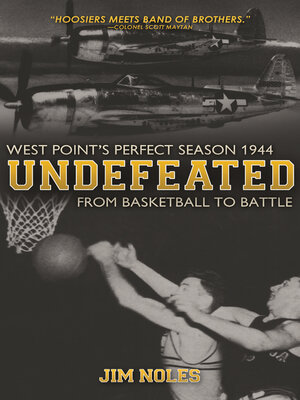
Sign up to save your library
With an OverDrive account, you can save your favorite libraries for at-a-glance information about availability. Find out more about OverDrive accounts.
Find this title in Libby, the library reading app by OverDrive.



Search for a digital library with this title
Title found at these libraries:
| Library Name | Distance |
|---|---|
| Loading... |
"A provocative, arresting, put-you-there account of a forgotten 1940s Army basketball team that we now realize shouldn't be forgotten" (Lars Anderson, New York Times–bestselling author).
In 1943, the West Point basketball team, the Cadets, had only managed a 5-10 record, and for the 1944 season, coach Ed Kelleher's hopes of reversing Army's fortunes rested on his five starters. They consisted of three seniors—team captain "Big Ed" Christl, John "Three Star" Hennessey, and class president Bobby Faas—and two juniors, Dale Hall and Doug Kenna.
As the new season opened in January of 1944, Kelleher's strategy paid handsome dividends. By the end of January, West Point was 6–0; by the end of February, the team boasted a 13-0 record. Of course, during those weeks, it only took a glance at the newspaper headlines to be reminded that there were far bigger contests than intercollegiate basketball afoot in the winter of 1944. The world was at war. The US Army needed its finest on the front line more than on the court, and the three seniors were soon destined for other battles . . .
In the years that followed, the Army's basketball team would never again have a chance to play in the NCAA tournament, and in the modern era, few remember West Point's perfect 1944 season. Although West Point's home basketball court is named the Edward C. Christl Arena, and the National Invitational Tournament's trophy is named after his coach, Edward A. Kelleher, too few people fully appreciate why. But after reading Undefeated, they will.
"Hoosiers meets Band of Brothers." —Col. Scott Maytan
In 1943, the West Point basketball team, the Cadets, had only managed a 5-10 record, and for the 1944 season, coach Ed Kelleher's hopes of reversing Army's fortunes rested on his five starters. They consisted of three seniors—team captain "Big Ed" Christl, John "Three Star" Hennessey, and class president Bobby Faas—and two juniors, Dale Hall and Doug Kenna.
As the new season opened in January of 1944, Kelleher's strategy paid handsome dividends. By the end of January, West Point was 6–0; by the end of February, the team boasted a 13-0 record. Of course, during those weeks, it only took a glance at the newspaper headlines to be reminded that there were far bigger contests than intercollegiate basketball afoot in the winter of 1944. The world was at war. The US Army needed its finest on the front line more than on the court, and the three seniors were soon destined for other battles . . .
In the years that followed, the Army's basketball team would never again have a chance to play in the NCAA tournament, and in the modern era, few remember West Point's perfect 1944 season. Although West Point's home basketball court is named the Edward C. Christl Arena, and the National Invitational Tournament's trophy is named after his coach, Edward A. Kelleher, too few people fully appreciate why. But after reading Undefeated, they will.
"Hoosiers meets Band of Brothers." —Col. Scott Maytan







